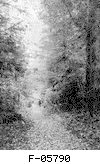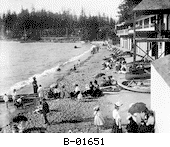 |
 |
 |
 |
 |
 |
 |
 |
 |
 |
 |
 |

|
|||||||

|
|

|
|||||
|
MAPPING EARLY VANCOUVER The story of the Brickmaker's claim details the first attempt to develop what would become the West End. John Morton, Samuel Brighouse and William Hailstone, the "Three Greenhorns," heard that there was coal along the shores of Burrard Inlet and decided to start a brick-making business there. On November 2, 1862, these men made the famous "Brickmaker's Claim," buying the 550 acres of land bounded by Burrard Street, English Bay, Stanley Park and Burrard Inlet. They paid one dollar an acre, which was a lot of money at the time. This land became the West End of Vancouver, which is now some of the most valuable real estate in Canada.
Unhappily, the "Three Greenhorns," as they came to be known, were unsuccessful in developing their land, which was then total wilderness. A group known as the Vancouver Improvement Company bought controlling interest in the property, but they also failed to arouse interest. Finally, in 1884 the Canadian Pacific Railroad was given control of one third of the land. It established an expensive and fashionable settlement on the northern edge of the West End for its executives and their families. The area became known as "Blueblood Alley" and maintained its prestige until the end of the 19th century. By this time, the "Greenhorns" had given up on the West End and moved on to settle other areas of the Fraser Valley.
Entertainment in the West EndTHE BEACH
At the end of the 19th century and the first two decades of the 20th century, English Bay was the gathering place for West End residents. It offered swimming, music, dancing, roller skating, shade and a fresh breeze. It was a place to discuss politics, fashion, sports and the goings-on of the community. It was a place for nice young men and women to meet, and a beautiful place for an evening stroll. Its popularity grew steadily throughout the 1890s, and with the opening of the Davie Street streetcar in 1898, it became the most popular beach in the city. Bathing fashions were a far cry from what is worn (or not worn!) on the beach today. Women wore long, cotton skirts and long-sleeved blouses, keeping all but the face and hands covered. They were careful to keep their faces shielded with a parasol, as a suntan was considered very unfashionable. Respectable gentlemen came to the beach in their Sunday best, which often included a three-piece suit, hat and tie. Younger men wore a one-piece cotton bathing suit with sleeves, while young ladies with their chaperons wore black skirts, stockings, and wore large bathing caps. Seraphim 'Joe' Fortes, the black lifeguard from Barbados, patrolled the beach to maintain standards of modesty and taught hundreds of children to swim in English Bay. DANCINGIn 1909 a pier was built, extending 100 yards into English Bay, from which people could launch boats and swim. At the end of the pier, a glassed-in dance hall called the "Prom" offered food, drink and music from the top dance bands of the day. ROLLER SKATINGRoller skating was an enormously popular turn-of-the-century pastime. The Imperial Roller Rink was built on the triangle bounded by Beach, Denman and Morton Streets. It featured roller skating lessons and polo played on roller skates. It burned down in the early twenties and has since become a park. SHOWS, BAND CONCERTS and SPORTSOn the sand, near the foot of Bidwell Street, was a small enclosure known as "Pirous." It offered vaudeville shows and various other forms of entertainment three nights a week during the summers. The Alexandra Park Bandstand was build in 1914 on the southern slope of the West End. It featured Sunday concerts, making Alexandra Park a prime location for picnics. The bandstand has recently been restored and Sunday concerts continue. By 1890, cyclists, horse riders and carriages enjoyed one of Vancouver's first properly graded roads which ran around Stanley Park. Nine years later, the first automobiles began touring the park. The city's important sporting events were held at Brockton Oval in Stanley Park. High school sports, rugby, cricket, lacrosse, bicycle-racing, and track and field meets brought out good crowds, among them G.A. Roedde and his family. Annual horse shows were held at the Horse Show Building at the end of Gilford Street. In 1911 the Denman Auditorium was built on the shores of Coal Harbour. It boasted the first artificial hockey ice surface in Canada, and the Vancouver Hockey Team won the Stanley Cup there in 1915! The Vancouver Rowing Club, the Stanley Park Pavilion, Lumberman's Arch, and the 9 o'clock gun were all familiar Stanley Park fixtures erected before the First World War. The first opera house in Vancouver, the CPR Opera House, opened in 1891. It was located on the corner of Granville and Robson, where Eatons now stands. Not quite so highbrow was the Savoy Music Hall, which featured a restaurant, saloon and music hall. The Alhambra Hotel on the corner of Howe and Pender featured the better vaudeville acts. To explore more of Old Vancouver click on a place name listed below.
|
|||||||




